Rob Machado Fin: Exploring Their Design and Impact


Intro
In the vibrant world of surfing, few things streamline the rider's experience like the fins attached to the board. Among the notable figures, Rob Machado stands out, creating a legacy not only as a surfer but as an innovator. With a keen understanding of both art and science, Machado designs fins that meld performance and aesthetics, enhancing the ride.
A Forethought on Fins
Fins play a crucial role in how a surfboard interacts with the water. They determine speed, stability, and maneuverability, making fin selection a pivotal aspect of any surfer's toolkit. This article will explore Machado's fin designs, focusing on their unique features, the philosophy underpinning their creation and the influence they wield on performance.
Key Points to be Discussed
- Technical Features: Dive into the specifics of Machado's fins, from shape to material, and how these contribute to performance in different surf conditions.
- Philosophical Approach: Understand the mindset that guides Machado in balancing functionality with aesthetics, perhaps drawing from the very essence of surfing culture.
- Industry Trends: Analyze how his designs reflect broader shifts in fin technology, contextualizing them within the surf culture's evolution.
- Practical Application: Tips on choosing the right fins for various surfing levels and conditions, ensuring surfers can maximize their experiences.
This guide is aimed at water sports enthusiasts, outdoor adventurers, and anyone passionate about enhancing their surfing game. Following this path, readers will emerge with a grasp of how Rob Machado’s fin design transcends mere accessory and becomes a pivotal tool in crafting an extraordinary surfing adventure.
Prolusion to Rob Machado Fin
In the world of surfing, fins play a crucial role in determining a surfer's performance on the water. Rob Machado, a name that resonates with countless beachgoers and surf enthusiasts, took fin design to a new level. This introductory segment explores the significance of Rob Machado's fin innovations and how they intertwine with the surfing experience.
Fins influence everything—from the speed a surfer gains while riding a wave to the control they maintain while maneuvering. In Machado’s case, his approach to fin design is not just about boosting functionality but also about adding a distinctive style to the surfboards they accompany.
Understanding the relationship between a fin's design and its impact on performance is key. It encompasses selecting the right shape, size, and material, all of which were pivotal in Machado's work. The goal? To ensure surfers can push their limits, honing their skills while being in sync with the ocean's rhythm.
Understanding the Essence of Fin Design
Fins are often underestimated in their capacity to alter the surfing experience. The design of a fin can dramatically change how a surfboard behaves in the water. For instance, wider fins typically offer more stability yet might hold back speed. Conversely, narrower fins can increase agility but may sacrifice some control.
When discussing fin design, it's critical to recognize the following elements:
- Shape: The outline of the fin influences how it interacts with water.
- Flexibility: Stiffer fins provide better drive while flexible ones allow for smoother turns.
- Placement: The position of the fin on a board affects balance and responsiveness.
In essence, a well-designed fin should cater to the specific needs of a surfer. Between the interplay of these characteristics, it becomes apparent that fin design is an art as much as it is science.
Rob Machado: The Surfer and Innovator
Rob Machado is not merely a world-class surfer; he also stands as a pioneer in surfboard fin technology. His passion for the ocean goes hand in hand with his revolutionary ideas about fin design. Machado’s perspective as a surfer allows him to foresee how design changes directly impact riding performance.
His fins reflect a blend of performance and aesthetics, showing that surf gear does not have to be purely utilitarian. Machado understands the essence of connecting with the wave, and his fin designs have been crafted to enhance this engagement.
Individuals who ride with his fins often note how they feel more connected to their board, allowing for smoother transitions and sharper turns. This unique combination of innovation and craftsmanship showcases Machado’s dedication to advancing surf technology while keeping the surfer’s experience at the forefront.
This complex relationship between fin design and performance—propelled by insights from an experienced surfer like Machado—sets a foundation for understanding the evolution of surfing gear. As we delve deeper into the anatomy and implications of fin choices, it’s essential to remember that each design tells a story, one that directly resonates with each wave ridden.
The Anatomy of a Surfboard Fin
Understanding the anatomy of a surfboard fin is crucial for any surfer looking to enhance their performance. Fins are not just simple attachments; they play a vital role in how a surfboard behaves in water. Each element contributes to a surfer’s ability to steer, maintain speed, and adapt to various wave conditions.
For a better grasp of how fins affect your ride, one must delve into the specific components and materials that define their identity. These aspects will aid surfers in selecting suitable fins that match their style and the conditions they face.
Components of Fins
The components that make up a fin dictate how it interacts with the water. Here are some critical parts:
- Base: This is the part of the fin that attaches to the board. It is essential for stability and offers a strong connection.
- Foil: The shape of the fin’s side profile determines how water flows over it. This, in turn, influences lift and drag — both essential for speed and maneuverability.
- Tip: The uppermost part of the fin plays a role in responsiveness. Fins with narrower tips tend to have better turn capabilities.
- Rake: The angle of the fin affects how the board engages with the water, influencing both control and speed.
Each component works in harmony with the others, so understanding their relationship allows surfers to make informed choices that suit their needs.
Materials Used in Modern Fin Construction
The materials that go into crafting fins significantly impact performance. Today’s fins are made from a variety of substances, each offering unique characteristics:
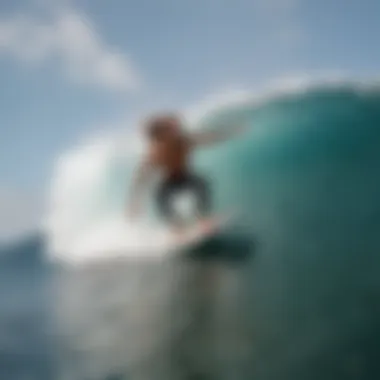
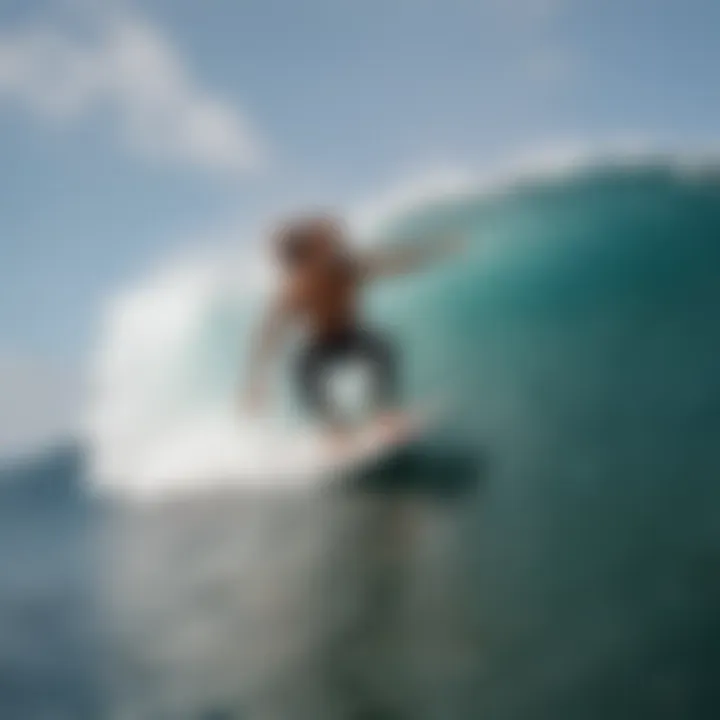
- Fiberglass: Known for its stiffness and durability, fiberglass fins often deliver a fine balance of flex and rigidity.
- Carbon Fiber: This lightweight material is favored for its strength-to-weight ratio. Fins made from carbon fiber tend to provide excellent performance while being incredibly responsive.
- Plastic: While heavier than the other materials, plastic fins are an economical choice. They work well for beginners or as a backup set.
- Foam: Some innovations involve molded foam fins, which are lightweight and can offer surprising performance in specific conditions.
Selecting the right material for fins hinges on personal preference and style of surfing. All these choices can influence a surfer’s experience on the water and ultimately their performance.
"Understanding your fins is as crucial as mastering your paddle strokes; both are vital to riding the waves better and with more confidence."
Rob Machado's Fin Design Philosophy
The philosophy behind Rob Machado's fin designs captures the imagination of surfers eager for performance, yet at the same time, it resonates with those who appreciate the finer points of craftsmanship. At its core, Machado’s approach intertwines aesthetics and functionality, a balance crucial for anyone who seeks not just to ride waves but to enjoy every nuanced twist in their surfing experience.
Machado embodies a unique vision—one that marries beauty to purpose. He understands that a fin doesn’t only serve the purpose of controlling a board in the water; it also contributes to the overall visual appeal of the surfboard. The vivid colors and artistic patterns his fins showcase elevate them beyond mere equipment, transforming them into an extension of the surfer's personality.
Furthermore, Machado's emphasis on sustainability is increasingly important. He's often called upon by brands to explore eco-friendly materials, which helps the environment while still meeting the high-performance expectations of surfers. By focusing on how fins can be environmentally friendly without compromising quality, he leads the charge in a movement that many outdoor enthusiasts appreciate.
Ultimately, Machado's design philosophyholds significant weight in the surfing community. It transcends the basic function of a fin and delves into how surfers perceive themselves and their gear. A thoughtfully designed fin can inspire confidence and enhance performance, which in turn invites surfers to chase their passion with renewed vigor.
"A surfer's connection to their equipment can redefine their experience on the water. When a fin feels right, magic happens." - Rob Machado
Balancing Aesthetics and Functionality
In the world of surfing, aesthetics often take a backseat to function, but that’s not the case with Machado’s creations. He understands that the best performance comes when the design is pleasing to the eye as well as effective in the water. It's about finding the right design that not only goes with the flow but also stands out among a sea of more mundane options.
The shapes he endorses aren't arbitrary. Each curve and detail serves a purpose, according to the conditions surfers face. Whether cruising in small, gentle waves or cutting through powerfully breaking surf, the ability of a fin to facilitate maneuverability and speed is matched equally by its design. A fin like Machado’s will often draw compliments while performing exceptionally well during a session.
Surfers are more likely to feel a genuine connection to their surfboards if the fins complement the overall aesthetics. When they combine striking visuals with top-notch functionality, surfers don't just ride the waves—they make a statement.
Performance Metrics to Consider
Understanding fin performance metrics can be crucial for any surfer looking to optimize their ride. When diving into the fins that Rob Machado designs, keep an eye on a few key metrics that can significantly affect performance:
- Flexibility: A fin's flexibility impacts how it responds to turns and waves. The right balance ensures that it can handle both sharp cuts and gentle arcs.
- Surface Area: Larger fins typically provide stability and better drive in small waves, while smaller ones allow for quick moves and pro-like maneuvers.
- Foil Shape: It refers to the shape of the fin. Different foils can change how water flows around the fin, affecting speed and control. Machado’s fins often showcase unique foil shapes that cater to various surfing styles.
- Base Width: The width of the fin base contributes to the board's overall stability. Wider bases are more stable, while narrower ones enhance maneuverability.
By factoring in these metrics, surfers can tailor their fin selection to match their surfing style and the conditions they’ll encounter. Machado’s designs invite surf enthusiasts to engage with these specifications actively, challenging them to think critically about their equipment. Matching the right fin to one’s peculiar technique opens up possibilities, from catching smaller waves to darting down steep, powerful breaks.
The Impact of Fins on Surfing Performance
Fins are not just an accessory; they are a critical component of a surfboard that can significantly influence performance on the wave. Whether you are an experienced rider or still fine-tuning your skills, understanding the role fins play can be the difference between a good ride and a great one.
When considering how fins impact surfing, it’s essential to think about three primary elements: speed, control, and manoeuvrability. These elements interplay to determine how well a surfer can engage with the water and execute their moves.
How Fins Influence Speed and Control
Fins contribute to speed by interacting with the water as the board moves. A well-designed fin creates lift, reducing drag and allowing a surfer to glide smoothly over the water’s surface. If you’ve ever felt like you were able to fly down a wave, you can thank the fin for that boost.
Moreover, control is driven by the shape and size of the fins. For example, larger fins can provide more grip, enabling smoother turns and sharper cuts on big waves. This grip can be a real game-changer during critical maneuvers, transforming an average ride into an exhilarating experience.
In practical terms, opting for a fin setup that matches your surfing style can lead to profound improvements. Surfers often report that the right fins allow for greater confidence while riding, encouraging them to push limits. When fins correlate well with speed and control, surfers find they can navigate a variety of wave conditions more skillfully.
"The right fin setup transforms a consistent ride into a powerful experience, encouraging surfers to challenge themselves on the waves."
Tailored Fin Configurations for Various Conditions
The ocean is a fickle beast; thus, fine-tuning fin configurations to match the conditions is essential. Different setups cater to varying wave sizes and types, and understanding this can greatly enhance your overall experience.
- In small, choppy waves, a thruster setup with smaller fins can give you the agility needed to maneuver easily. The fins will help maintain control without generating excess drag.
- Meanwhile, in larger, more powerful surf, switching to larger, more rigid fins and possibly adding a quad setup can provide the stability required to ride bigger swells and maintain control during critical sections of the wave.
- Additionally, conditions like heavy currents or wind can warrant a reassessment of your fin configuration. A fin designed for added hold can make all the difference in such scenarios, allowing for smoother rides despite challenging conditions.
Ultimately, understanding how to tailor your fin setup to your environment will amplify your performance, making it critical knowledge for any surfer keen on advancing their skills. Investing time into learning about fin configurations will yield dividends in ride quality, satisfaction, and even safety in the unpredictable realm of surfing.
Exploring Different Fin Shapes and Sizes
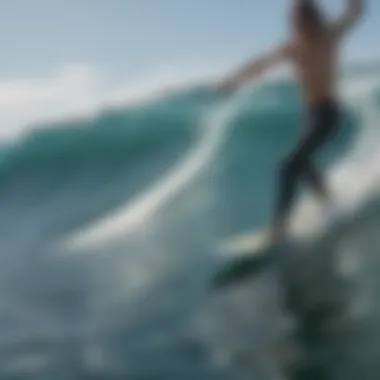
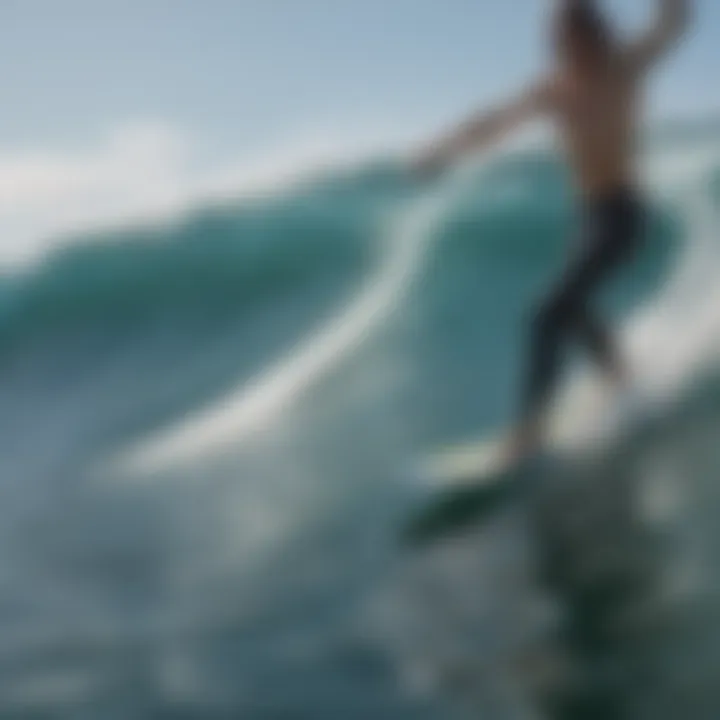
When it comes to surfboard performance, understanding the nuances of different fin shapes and sizes is crucial. The choices a surfer makes in this area can significantly influence their ride. Fins are not just accessories, they play a key role in maneuverability, speed, and overall control on the water.
Recommended Fins for Beginners
Starting a journey into surfing can be as overwhelming as trying to navigate stormy seas. Beginners often feel lost when it comes to fin selection. However, choosing the right fins can enhance stability and ease learning. For novices, a wider base with a more upright design might be ideal. This combination typically contributes to better stability and control, making it easier for surfers to maintain balance and execute turns.
Here are some fins to consider for those just starting out:
- FCS II Performer - This fin offers a versatile template suitable for a variety of conditions, making it a good choice for new surfers.
- Future Fins Seaside Series - With a more forgiving feel, this fin is great for helping beginners find rhythm while paddling and riding.
- M7 by FCS - Known for its forgiving nature, it’s perfect for those still figuring out the waves.
Advanced Fin Choices for Experienced Surfers
Once surfers get their feet under them, the hunt for performance-enhancing gear begins. Experienced surfers often look for fin setups that complement their personal style, as well as the conditions they typically face. Here, specificity and subtlety in fin choice can lead to major performance differences.
For advanced surfers, consider the following options:
- FUTURE FINS 5-FIN SET - These fins provide various configurations, allowing surfers to switch setups based on their needs.
- FCS II K2.1 - A favourite among pro surfers, known for its speed and responsiveness in critical waves.
- True Ames Honeycomb Fins - Exceptional in performance, it allows for precise control, especially in heavy surf.
Tips for Selecting the Right Fin Setup
Picking fins is like choosing the right tool for a job; the right setup can make all the difference in achieving the desired outcomes. Here are some pointers to navigate this often tricky terrain:
- Evaluate your surf style - Whether you favor explosive turns or smooth rides, this will influence the fin shape.
- Consider the wave conditions - High-performance fins may not be necessary in smaller, softer waves. Match the fin size and shape with the wave types you'll encounter.
- Experiment - Don't be afraid to tweak and try different setups. It’s part of honing your talent in the water.
"The more you paddle out, the more you’ll discover what suits your style—trial and error can lead to the best breakthroughs."
Ultimately, understanding different fin shapes and sizes isn't just academic; it’s where the rubber meets the road in surfing. Selecting the right fins equips surfers to tackle varying conditions and heightens their overall experience. By offering tailored choices aligned with their skill level and surfing habits, surfers can truly embrace the art of riding the waves.
Rob Machado Fin Comparisons
In the realm of surfing, the fin plays a pivotal role far beyond mere aesthetics. Fin selection can significantly affect performance in terms of speed, maneuverability, and control. Therefore, a comparison of Rob Machado's fins with those from other reputable brands is not just a matter of preference but one anchored in understanding functionality, design philosophy, and how these elements come together to improve your ride. This section endeavors to break down the nuances of these comparisons, pinpointing what surfers can gain by opting for Rob Machado's renowned designs versus various alternatives.
Comparative Analysis with Other Top Brands
When one ponders over surfboard fins, the conversation naturally gravitates towards the heavy-hitters in the industry, such as Future Fins, FCS, and True Ames. Each brand boasts of cutting-edge technology and innovative designs. However, what truly sets Rob Machado's fins apart is his unique blend of artistry and functionality exchanged with extensive in-water testing.
- Future Fins: Known for their versatile setups, Future Fins often target performance across various conditions. Surfers may find their fin template slightly stiffer compared to Rob Machado’s, which often provides a more fluid feel during turns, a characteristic prized by many.
- FCS: FCS fins are highly regarded for their quick-release systems and wide array of options. Though they offer significant customization, some riders have noted that Rob Machado fins tend to provide a more cohesive feel due to Machado's integrated design, which corresponds to his surfing style and intended use.
Rob's fins, particularly, incorporate a specific flex that dynamically reacts to the wave's pressure, something that not all brands can replicate. Surfers who prioritize responsiveness would find Machado’s designs appealing.
Real-World User Experiences
To understand how Rob Machado's fins function in real-life conditions, we must turn to the voices who really matter—the surfers themselves. Feedback gathered from various online communities, including discussion threads on platforms like Reddit and dedicated surf forums, offers illuminating insights.
Many seasoned surfers highlight that after switching to Machado's fin designs, they experienced:
- Enhanced maneuverability: Surfers often puzzle over how certain fins can seemingly pick up speed on the face of a wave and still hold tight on a bottom turn. Users frequently share stories about improved performance when employing Rob's fins, enjoying how easily they could change direction, a vital factor in critical sections of a ride.
- Comfort and confidence: The feedback often highlights a newfound sense of confidence in their ability to navigate different wave conditions. Surfers who previously struggled with specific maneuvers have credited their success to the added stability provided by Machado’s fins.
From newbie surfers to experts, many users point out that with Rob Machado fins, they gain not just an accessory to their board, but a genuine enhancement of their overall riding experience.
"Switching to Rob’s fins was a game-changer; more than once, I managed to pull off tricks I thought were out of reach, all thanks to how they engage with the water!"
Every ounce of feedback underscores the tangible benefits achieved through mindful fin selection, particularly when discussing Rob Machado's focus on performance in real-world surfing scenarios.
In summary, while options abound from various brands, Rob Machado’s fin designs stand out through user experiences and performance feedback that illustrate a blend of science and artistry aimed at improving the surfing journey.
Innovations in Fin Technology
The world of surfing is ever-evolving, and so are the technologies that drive its performance. Innovations in fin technology have become pivotal, not just for the professional surfer seeking an edge, but also for everyday enthusiasts wanting an exhilarating experience on the waves. As we dive into the intricacies of Rob Machado’s fin designs, understanding these innovations is key, shedding light on their advantages and potential applications.

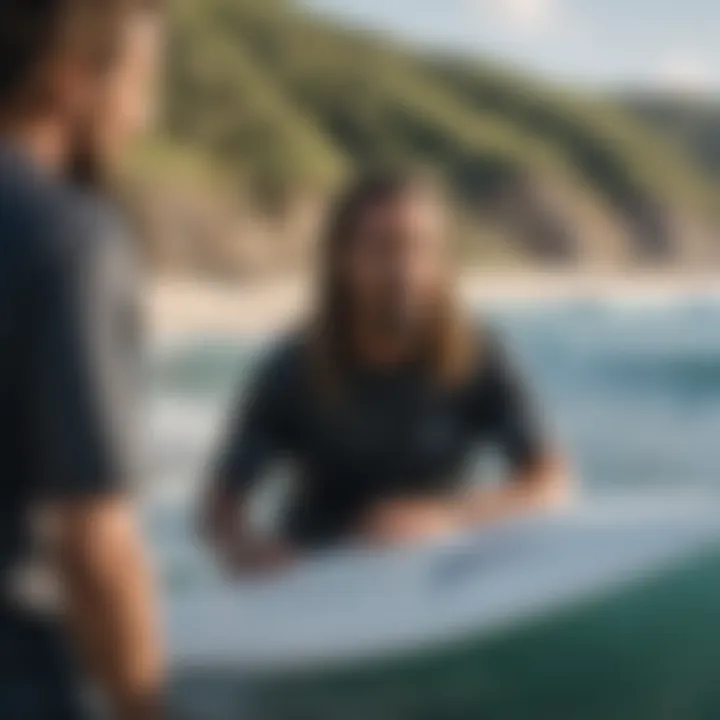
Advancements in Materials and Design
The materials used to craft fins have come a long way since the days of simple fiberglass. Contemporary fins often utilize a mix of high-grade plastics, carbon fiber, and a variety of composite materials that contribute to a stronger, lighter product.
For instance, carbon fiber fins are incredibly popular due to their lightweight nature and high stiffness. A fin constructed from this material not only provides superior performance in controlled flex and rigidity but also minimizes drag, allowing surfers to maintain speed without compromising maneuverability.
On the design front, many manufacturers have started employing computer-aided design (CAD) software to simulate water flow over fin shapes, enabling precise adjustments that maximize performance potential. Imagine being able to calibrate the fin’s profile to ensure optimal hold in hollow waves or increased lift for broader turns—this is now possible thanks to technological advancements.
- Benefits of Modern Materials:
- Lighter weight reduces fatigue on long surf sessions.
- Enhanced durability against wear and tear from harsh ocean conditions.
- Improved responsiveness and feel, enhancing surfer control.
Incorporating principles of hydrodynamics into the design has also become commonplace. With innovations like variable flex patterns, fin designs are tailored to perform optimally at various speeds and conditions, ensuring surfers experience the best possible ride in just about any environment.
Future Trends in Surfboard Fin Design
As we look toward the horizon, it’s evident that fin technology will continue to expand. One of the most exciting trends is the integration of smart technology in surf fins. Picture fins equipped with sensors that gather data on wave height, speed, and even the surfer's performance metrics. This data could prove invaluable for training and refining a surfer’s technique.
Moreover, as sustainability takes center stage in all aspects of manufacturing, eco-friendly fins are bound to gain traction. From biodegradable materials to recycled plastics, the future may hold a movement away from traditional materials towards greener solutions.
Further, we can expect advancements in adjustable fin systems that allow surfers to modify their fin setup on-the-fly. This could enable surfers to adapt quickly to changing conditions or personal preferences while minimizing the need to carry multiple fins.
"The next generation of surf fins will not only adapt to the waves but also connect with the surfer, providing real-time feedback and adjustments."
Ultimately, innovations in fin technology signify not only a leap in performance but also a commitment to sustainability and adaptability. With each advancement, surfers are better equipped to navigate the complexities of the ocean, ensuring that every ride is not just enjoyable, but also a reflection of the latest in surfboard engineering.
Caring for Your Fins
Caring for your fins is often an overlooked aspect of surfing, yet it holds considerable weight in ensuring optimal performance and longevity. Just like any other gear, surfboard fins require regular attention to maintain their shape and function. These small pieces of equipment play a crucial role in your overall surfing experience, influencing how a surfboard reacts to the waves and how well you can control your ride. Fins that are not well-maintained or properly stored can lead to diminished performance and even more severe damage to your surfboard in the long run.
The importance of caring for your fins goes beyond mere aesthetics. It can affect everything from speed and maneuverability to stability and traction on the water. A little preventive care can save you from costly replacements or further complications down the line. In essence, treating your fins with the respect they deserve can enhance not only your gear but your entire surfing experience.
Routine Maintenance for Longevity
Consistent upkeep is essential to extend the lifespan of your fins. Here are some simple routines to incorporate into your care regimen:
- Rinse After Each Use: Always rinse your fins with fresh water after every surf session. This removes salt, sand, and any debris that might accumulate, preventing corrosion and wear over time.
- Inspect for Damage: Regularly check for any signs of cracks, chips, or deformities. Even small damages may worsen if left unaddressed.
- Dry Thoroughly: Ensure your fins are completely dry before storing them. This reduces the likelihood of mold and deterioration.
- Polish the Fins: A quick polish can help maintain the surface finish, especially if you're using fiberglass fins. Use a soft cloth for this to avoid scratching.
Building these habits into your routine might seem tedious at first, but they can dramatically increase the lifespan of your fins.
Storing Fins Properly to Avoid Damage
When it comes to storing your fins, adequate care is paramount. Improper storage can lead to warping, delamination, or even breakage. Below are some steps to consider for proper fin storage:
- Keep Fins in a Bag: Use a padded fin bag or a dedicated compartment in your surfboard bag. This keeps them safe from physical impacts and scratches.
- Avoid Direct Sunlight: Store your fins in a shaded area or in a closet away from direct sunlight. Exposure to UV rays can weaken the materials over time.
- Separate Each Fin: If using a bag that holds multiple fins, ensure each fin stays separate to avoid them scratching each other or developing pressure points.
- Store Indoors: Always store your fins indoors where the temperature is controlled. Extreme heat or cold can affect the structure and performance of your fins.
"Taking care of your fins is not only about preservation; it's about optimizing your surf experience and ensuring you’re ready to tackle any wave."
With these practices in play, not only will you prolong the life of your fins, but you'll also ensure your surfboard operates at its best. Proper fin care can't be underestimated—it's a small investment in effort that yields big returns on performance.
Finale
Evaluating the Importance of Fin Selection
Choosing the right fin can significantly affect a surfer's performance. The fin’s design, shape, and material can either enhance or hinder a person's riding experience. Selecting the proper fin is like finding the right pair of shoes; it makes all the difference, from comfort to efficiency. For surfers, understanding fin selection is crucial as it aligns with their skill level and expected conditions. Factors like wave size, personal surfing style, and board type all play a role.
In evaluating fin importance, consider how different fin setups create various effects on maneuverability and stability. For instance, a larger fin generally provides better grip in powerful waves, ideal for those who prefer aggressive styles. In contrast, smaller fins might offer more speed and looseness, allowing for creative surfing maneuvers. Thus, the right fin isn’t just an accessory; it is essential for optimizing your surfing experience.
Final Thoughts on Rob Machado's Legacy
Rob Machado's influence on the surfing community extends beyond his athletic achievements; it carves a path for future innovations in fin design. His quest for harmony between performance and artistry echoes throughout the surfing world. Machado reminds us that surfing is not just a sport but also a form of expression.
His legacy lives through the detailed craftsmanship and thoughtfulness embedded in his fin designs. Each fin crafted under his vision reflects a deep understanding of the waves and the surfer’s interaction with them. In surfing, where the essence of balancing aesthetics and functionality reigns, Machado leads the charge by pushing boundaries.
"Rob Machado reminds us that the right tools, just like the right mindset, can change the game."
As enthusiasts and newcomers sift through the multitude of options available today, Machado's ideals serve as a guiding light, quietly encouraging surfers to think critically about their equipment, making informed choices in an endeavor that thrives on the merging of art and sport.















